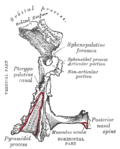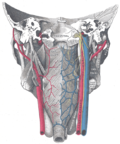Medial pterygoid muscle
| General Information | |
|---|---|
| Latin | Musculus pterygoideus medialis |
| Greek | |
| TA98 | |
| TA2 | |
| FMA | |
| Details | |
| System | Muscular system |
| Artery | |
| Vein | |
| Nerve | Mandibular nerve |
| Lymphatic drainage | |
| Precursor | |
| Function | |
| Identifiers | |
| Clinical significance | |
| Notes | |
The Medial Pterygoid Muscle is one of the muscles of mastication. It is a thick, quadrilateral muscle that is similar in structure and function to the masseter muscle.
Origin and Insertion[edit]
The Medial Pterygoid Muscle originates from the medial surface of the lateral pterygoid plate, the pyramidal process of the palatine bone, and the maxillary tuberosity. It inserts into the medial surface of the angle and lower half of the ramus of the mandible.
Function[edit]
The Medial Pterygoid Muscle works in conjunction with the lateral pterygoid muscle to allow the jaw to open and close, and to move side to side. It also helps to elevate and protrude the mandible.
Clinical Significance[edit]
Dysfunction of the Medial Pterygoid Muscle can lead to temporomandibular joint disorder, a condition that can cause pain and difficulty in moving the jaw.
See Also[edit]
```
This is a basic structure and you can add more sections as needed. Remember to always cite your sources and follow the guidelines of the specific wiki you are contributing to.
-
Medial pterygoid muscle
-
Medial pterygoid muscle
-
Medial pterygoid muscle
-
Medial pterygoid muscle
-
Medial pterygoid muscle
-
Medial pterygoid muscle
-
Medial pterygoid muscle
-
Medial pterygoid muscle
-
Medial pterygoid muscle
-
Medial pterygoid muscle
-
Medial pterygoid muscle
-
Medial pterygoid muscle
Ad. Transform your life with W8MD's Budget GLP-1 injections from $75


W8MD offers a medical weight loss program to lose weight in Philadelphia. Our physician-supervised medical weight loss provides:
- Weight loss injections in NYC (generic and brand names):
- Zepbound / Mounjaro, Wegovy / Ozempic, Saxenda
- Most insurances accepted or discounted self-pay rates. We will obtain insurance prior authorizations if needed.
- Generic GLP1 weight loss injections from $75 for the starting dose.
- Also offer prescription weight loss medications including Phentermine, Qsymia, Diethylpropion, Contrave etc.
NYC weight loss doctor appointmentsNYC weight loss doctor appointments
Start your NYC weight loss journey today at our NYC medical weight loss and Philadelphia medical weight loss clinics.
- Call 718-946-5500 to lose weight in NYC or for medical weight loss in Philadelphia 215-676-2334.
- Tags:NYC medical weight loss, Philadelphia lose weight Zepbound NYC, Budget GLP1 weight loss injections, Wegovy Philadelphia, Wegovy NYC, Philadelphia medical weight loss, Brookly weight loss and Wegovy NYC
|
WikiMD's Wellness Encyclopedia |
| Let Food Be Thy Medicine Medicine Thy Food - Hippocrates |
Medical Disclaimer: WikiMD is not a substitute for professional medical advice. The information on WikiMD is provided as an information resource only, may be incorrect, outdated or misleading, and is not to be used or relied on for any diagnostic or treatment purposes. Please consult your health care provider before making any healthcare decisions or for guidance about a specific medical condition. WikiMD expressly disclaims responsibility, and shall have no liability, for any damages, loss, injury, or liability whatsoever suffered as a result of your reliance on the information contained in this site. By visiting this site you agree to the foregoing terms and conditions, which may from time to time be changed or supplemented by WikiMD. If you do not agree to the foregoing terms and conditions, you should not enter or use this site. See full disclaimer.
Credits:Most images are courtesy of Wikimedia commons, and templates, categories Wikipedia, licensed under CC BY SA or similar.
Translate this page: - East Asian
中文,
日本,
한국어,
South Asian
हिन्दी,
தமிழ்,
తెలుగు,
Urdu,
ಕನ್ನಡ,
Southeast Asian
Indonesian,
Vietnamese,
Thai,
မြန်မာဘာသာ,
বাংলা
European
español,
Deutsch,
français,
Greek,
português do Brasil,
polski,
română,
русский,
Nederlands,
norsk,
svenska,
suomi,
Italian
Middle Eastern & African
عربى,
Turkish,
Persian,
Hebrew,
Afrikaans,
isiZulu,
Kiswahili,
Other
Bulgarian,
Hungarian,
Czech,
Swedish,
മലയാളം,
मराठी,
ਪੰਜਾਬੀ,
ગુજરાતી,
Portuguese,
Ukrainian











